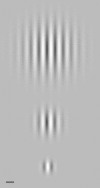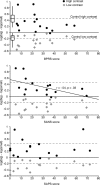Weakened center-surround interactions in visual motion processing in schizophrenia
- PMID: 17079669
- PMCID: PMC6674537
- DOI: 10.1523/JNEUROSCI.2592-06.2006
Weakened center-surround interactions in visual motion processing in schizophrenia
Abstract
Schizophrenia is often accompanied by a range of visual perception deficits, with many involving impairments in motion perception. The presence of perceptual abnormalities may impair neural processes that depend on normal visual analysis, which in turn may affect overall functioning in dynamic visual environments. Here, we examine the integrity of suppressive center-surround mechanisms in motion perception of schizophrenic patients. Center-surround suppression has been implicated in a range of visual functions, including figure-ground segregation and pursuit eye movements, visual functions that are impaired in schizophrenia. In control subjects, evidence of center-surround suppression is found in a reduced ability to perceive motion of a high-contrast stimulus as its size increases. This counterintuitive finding is likely a perceptual correlate of center-surround mechanisms in cortical area MT. We now show that schizophrenic patients exhibit abnormally weak center-surround suppression in motion, an abnormality that is most pronounced in patients with severe negative symptoms. Interestingly, patients with the weakest surround suppression outperformed control subjects in motion discriminations of large high-contrast stimuli. This enhanced motion perception of large high-contrast stimuli is consistent with an MT abnormality in schizophrenia and has a potential to disrupt smooth pursuit eye movements and other visual functions that depend on unimpaired center-surround interactions in motion.
Figures






Similar articles
-
Suppressive mechanisms in visual motion processing: From perception to intelligence.Vision Res. 2015 Oct;115(Pt A):58-70. doi: 10.1016/j.visres.2015.08.005. Epub 2015 Sep 2. Vision Res. 2015. PMID: 26299386 Free PMC article. Review.
-
Eye movement and visual motion perception in schizophrenia II: Global coherent motion as a function of target velocity and stimulus density.Exp Brain Res. 2007 Sep;182(3):415-26. doi: 10.1007/s00221-007-1003-3. Epub 2007 Jun 14. Exp Brain Res. 2007. PMID: 17569035
-
Improved motion perception and impaired spatial suppression following disruption of cortical area MT/V5.J Neurosci. 2011 Jan 26;31(4):1279-83. doi: 10.1523/JNEUROSCI.4121-10.2011. J Neurosci. 2011. PMID: 21273412 Free PMC article.
-
Development of Center-Surround Suppression in Infant Motion Processing.Curr Biol. 2019 Sep 23;29(18):3059-3064.e2. doi: 10.1016/j.cub.2019.07.044. Epub 2019 Sep 5. Curr Biol. 2019. PMID: 31495583
-
And yet it moves: perceptual illusions and neural mechanisms of pursuit compensation during smooth pursuit eye movements.Neurosci Biobehav Rev. 2012 Jan;36(1):143-51. doi: 10.1016/j.neubiorev.2011.05.005. Epub 2011 May 17. Neurosci Biobehav Rev. 2012. PMID: 21616092 Review.
Cited by
-
Migraine increases centre-surround suppression for drifting visual stimuli.PLoS One. 2011 Apr 11;6(4):e18211. doi: 10.1371/journal.pone.0018211. PLoS One. 2011. PMID: 21494594 Free PMC article.
-
Reduced visual surround suppression in schizophrenia shown by measuring contrast detection thresholds.Front Psychol. 2014 Dec 10;5:1431. doi: 10.3389/fpsyg.2014.01431. eCollection 2014. Front Psychol. 2014. PMID: 25540631 Free PMC article.
-
Postural Stability of Patients with Schizophrenia during Challenging Sensory Conditions: Implication of Sensory Integration for Postural Control.PLoS One. 2016 Jun 29;11(6):e0158219. doi: 10.1371/journal.pone.0158219. eCollection 2016. PLoS One. 2016. PMID: 27355830 Free PMC article.
-
Validation of motion perception of briefly displayed images using a tablet.Sci Rep. 2018 Oct 30;8(1):16056. doi: 10.1038/s41598-018-34466-9. Sci Rep. 2018. PMID: 30375459 Free PMC article.
-
Modularity in the motion system: independent oculomotor and perceptual processing of brief moving stimuli.J Vis. 2014 Mar 24;14(3):28. doi: 10.1167/14.3.28. J Vis. 2014. PMID: 24665091 Free PMC article.
References
-
- Albright TD, Desimone R. Local precision of visuotopic organization in the middle temporal area (MT) of the macaque. Exp Brain Res. 1987;65:582–592. - PubMed
-
- Allman J, Meizin F, McGuiness E. Direction- and velocity-specific responses from beyond the classical receptive field in the middle temporal visual area (MT) Perception. 1985;14:105–126. - PubMed
-
- Andreasen NC, Olsen S. Negative v positive schizophrenia: definition and validation. Arch Gen Psychiatry. 1982;39:789–794. - PubMed
-
- Andreasen NC, O'Leary DS, Flaum M, Nopoulos P, Watkins GL, Boles Ponto LL, Hichwa RD. Hypofrontality in schizophrenia: distributed dysfunctional circuits in neuroleptic-naive patients. Lancet. 1997;349:1730–1734. - PubMed
-
- Betts LR, Taylor CP, Sekuler AB, Bennett PJ. Aging reduces center-surround antagonism in visual motion processing. Neuron. 2005;45:361–366. - PubMed
Publication types
MeSH terms
Grants and funding
LinkOut - more resources
Full Text Sources
Medical
